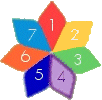
Red star* = updated* or added**.
- This section only covers metadata standards for data structures (refer to {1} in the illustration on the right). Information about standards for data contents {2} and data values {3} can be found in Section 6 Metadata value space.
- In the metadata community, the word schema means the semantic and structural definitions of metadata elements, including the relationships between those elements, being represented in standardized syntax or “serialization” format.
- Metadata schemas are also called element sets, property vocabularies).
- They generally specify names of elements and their semantics.
- Optionally, they may specify:
- rules for how content must be formulated (for example, how to identify the main title),
- representation rules for content (for example, capitalization rules), and
- allowable content values (for example, terms must be used from a specified controlled vocabulary).
- Many metadata schemas are being developed in a variety of user environments and disciplines.
- Some of the most common ones are listed on this page.
- An expanded list of schemes and element sets is provided in another site.
Metadata standards for data structures
4.1 Information Resource Description
- DUBLIN CORE
http://dublincore.org/
- Dublin Core Metadata Element Set ("The Dublin Core")
http://dublincore.org/documents/dces/ , ISO 15836-1:2017 [ISO 15836-1:2017].
- DCMI Metadata Terms ("Dublin Core terms"):
http://dublincore.org/documents/dcmi-terms/ ISO 15836-2:2019 [ISO 15836-2:2019]This is a standard for cross-domain information resource description. It is a U.S. national and international standard.
- Including:
- The 15 elements from the Dublin Core Metadata Element Set
- Several dozen properties, classes, datatypes, and vocabulary encoding schemes
- MARC and MODS family
- MARC (MAchine-Readable Cataloging)
http://lcweb.loc.gov/marc/
MARC provides the mechanism by which computers exchange, use, and interpret bibliographic information, and its data elements make up the foundation of most library catalogs used today. MARC became USMARC in the 1980s and MARC 21 in the late 1990s.MODS (Metadata Object Description Schema)
http://www.loc.gov/standards/mods/
MODS includes a subset of MARC fields and uses language-based tags rather than numeric ones, in some cases regrouping elements from the MARC 21 bibliographic format. MODS is expressed using the XML schema language of the World Wide Web Consortium.- Schema.org
http://schema.org/
Schema.org is sponsored by major search engines (Google, Microsoft, Yahoo and Yandex) for webmasters and developers to use. The shared schemas, covering almost all kinds of entities that websites may contain, are developed by an open community process, using the public-schemaorg@w3.org mailing list and through GitHub.
4.2 Cultural Objects and Visual Resources
- Categories for the Description of Works of Art (CDWA)
http://www.getty.edu/research/publications/electronic_publications/cdwa/index.html
A standard for describing works of art, architecture, groups of objects, and visual and textual surrogates.
- VRA Core Categories version 4.0
http://www.loc.gov/standards/vracore/
For creating records to describe works of visual culture as well as the images that document them.
- Lightweight Information Describing Objects (LIDO)
http://network.icom.museum/cidoc/working-groups/lido/what-is-lido/
An XML harvesting schema for contributing content to cultural heritage repositories.
Version 1.0 overview
Version 1.1 (published 2021-12-20)
4.3 Educational-purpose
- The Learning Resource Metadata Initiative (LRMI)
http://dublincore.org/dcx/lrmi-terms/1.1/
For making it easier to publish, discover, and deliver quality educational resources on the web
4.4 Archives and Preservation
- EAD (Encoded Archival Description)
http://lcweb.loc.gov/ead/
A standard for encoding archival finding aids using Extensible Markup Language (XML).
EAD3
- PREMIS (Preservation Metadata: Implementation Strategies)
Data Dictionary for Preservation Metadata
Version: 3.0 http://www.loc.gov/standards/premis/v3/index.html
Defines “core” set of preservation metadata elements, with supporting data dictionary, applicable to a broad range of digital preservation activities4.5 E-Commerce, rights
- The INDECS project
The <indecs> metadata framework: Principles, model and data dictionary
http://www.doi.org/topics/indecs/indecs_framework_2000.pdf
Created to address the need, in the digital environment, to put different creation identifiers and their supporting metadata into a framework where they could operate side by side, especially to support the management of intellectual property rights. The main focus of <indecs> is the use of what is commonly (if imprecisely) called content or intellectual property.
- ONIX (Online Information Exchange)
http://www.editeur.org/onix.html
Built on the <indecs> Framework, developed and maintained by EDItEUR jointly with book industries.
The ONIX for Books Product Information Message is the international standard for representing and communicating book industry product information in electronic form. It has elements to record a wide range of evaluative and promotional information as well as basic bibliographic and trade data.
- DOI (Digital Object Identifier) system
http://www.doi.org/
DOI Handbook http://www.doi.org/hb.html
- Open Digital Rights Language (ODRL)
ODRL Ontology http://www.w3.org/ns/odrl/2/
4.6 Agents
- The Friend of a Friend (FOAF)
http://xmlns.com/foaf/spec/
- The FOAF project is based around the use of machine readable Web homepages for people, groups, companies, etc. The "FOAF vocabulary" provides a collection of basic terms that can be used in these Web pages.
- vCARD
vCard Ontology - for describing People and Organizations
http://www.w3.org/TR/vcard-rdf
- This note specifies a Resource Description Framework (RDF) expression that corresponds to the vCard electronic business card profile defined by RFC 2426 [VCARD].
4.7 Science Data
- Content Standards for Digital Geospatial Metadata (CSDGM)
http://www.fgdc.gov/metadata/csdgm/index_html
A standard for supporting the collection and processing of geospatial metadata. It is intended to be usable by all levels of government and the private sector.
- Darwin Core specification
http://rs.tdwg.org/dwc/index.htm
For biodiversity occurrence data.4.8 Media-Specific
- MPEG-4 and MPEG-7 for Audio and Video [ISO/IEC standards developed by *MPEG (Moving Picture Experts Group)]
- MPEG-4
A standard for multimedia of the fixed and mobile web.
Overview: http://mpeg.chiariglione.org/standards/mpeg-4
- MPEG-7
A standard for description and search of audio and visual content.
= Multimedia Content Description Interface
Overview: http://mpeg.chiariglione.org/standards/mpeg-74.9 More
- An expanded list of metadata element sets and application profiles -- see appendix at metadataetc.org site
- Linked Open Vocabularies (LOV)
URL: https://lov.linkeddata.es/dataset/lov/
A dataset of descriptions of RDFS vocabularies or OWL ontologies defined for and used by LD datasets.<-- Back to Table of Contents |||| Go to Next Section -->